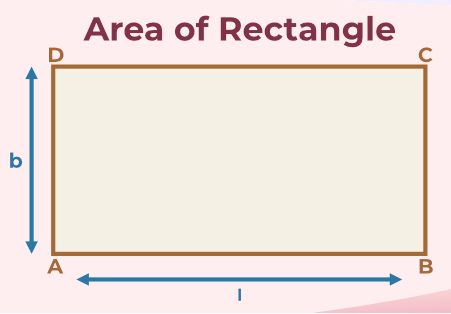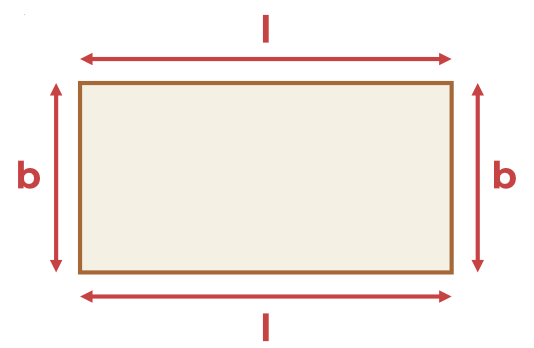Properties of the Rectangle are the facts and statements that differentiate it from other quadrilaterals. We know that quadrilaterals are polygons that are formed by joining four straight lines. A rectangle is a special type of quadrilateral with opposite sides parallel and equal and each interior angle of the rectangle is 90 degrees. It is a sub-category of the parallelogram and it has various properties. The properties of a rectangle differentiate it from other polygons, especially quadrilaterals.
In this article, we will learn about the various properties of a rectangle, formulas associated with it, types of rectangles, and others in detail.
What is a Rectangle?
We define a rectangle as a closed figure that has four sides and the angle formed by adjacent sides is 90°. The opposite sides of the rectangle are parallel and equal. A rectangle also has two diagonals and the two diagonals of the rectangle are equal.
In general, a rectangle has two sides with lengths greater than the other two sides and the longer sides are called length denoted with “l” whereas the shorter side is called breadth and is denoted as, “b”. The image of a rectangle with length “l” and breadth “b” is added below:

What are the Properties of a Rectangle?
A rectangle can have various properties. Some of the Properties of a Rectangle are discussed below.
- Rectangle is a Polygon with four sides.
- Rectangle is a Quadrilateral.
- In a rectangle opposite sides are Parallel and Equal.
- A rectangle has all the properties of a parallelogram and hence a rectangle is also called a parallelogram.
- All four interior angles of the rectangle are equal and the value of each angle is 90°.
- The sum of all the interior angles in a rectangle is 360°.
- The sum of all the exterior angles in a rectangle is 360°.
- Opposite sides of a Rectangle are Equal and Parallel.
- The diagonals of a rectangle are bisectors of each other.
- The diagonals of a rectangle are equal to each other.
- Length of the diagonal is found by Pythagoras theorem. If the length and the breadth of the rectangle are l and b respectively then the diagonal of the rectangle is d = √( l2 + b2).
Various formulas are used to find the area, perimeter, and others associated with a quadrilateral. Similarly, we have various formulas that are used to find the area, perimeter, and diagonal of the rectangle. Now let’s discuss the Rectangle formula.
Area of Rectangle Formula
In a rectangle, if the length(l) and breadth(b) are given then the area of the rectangle is found using the formula,
Area of Rectangle = l × b
The space enclosed by the boundary of rectangle ABCD is the area of the rectangle and the figure representing the area of the rectangle is added below,

Perimeter of Rectangle Formula
In a rectangle, if the length(l) and breadth(b) are given then the perimeter of the rectangle is found using the formula,
Perimeter of Rectangle = 2 (l + b)
The sum of all the boundaries of the rectangle ABCD is the perimeter of the rectangle and the figure representing the perimeter of the rectangle is added below,

(breadth) b = A/l
Diagonal of Rectangle Formula
In the figure added above where ABCD is a rectangle, the AC represents the diagonal of a rectangle. If the length and the breadth of the rectangle are l and b respectively then the diagonal of the rectangle is
d = √( l2 + b2)
Types of Rectangles
We know that a rectangle is a type of quadrilateral and three are basic two types of rectangles, that are
Let’s learn about each of them in detail.
Square
A quadrilateral with opposite sides parallel and equal is a rectangle, and in the case of the square it has opposite sides parallel and equal, and hence we consider it a rectangle. A square is a special rectangle in which all the sides are also equal. The image of a square is shown below:

The image added above is a square ABCD where side AB, BC, CD, and DA are equal and ∠A, ∠B, ∠C, and ∠D are equal.
Golden Rectangle
A rectangle in which the ‘length to the width’ ratio is similar to the golden ratio, i.e. equal to the ratio of 1: (1+⎷5)/2 is called the golden rectangle.
Thus, in a golden rectangle, the sides are in the ratio of 1: 1.618… and, if its width is 1 m then its length is 1.168 m. The image of a Golden Rectangle is shown below:

Conclusion
In conclusion, the article on “Properties of Rectangle” provides a comprehensive overview of the fundamental characteristics that distinguish rectangles from other quadrilaterals. It emphasizes that a rectangle is a special type of polygon with four sides, where opposite sides are parallel and equal, and each interior angle measures 90°. The article also highlights the rectangle’s association with parallelograms, its equal diagonals, and the application of the Pythagorean theorem to calculate diagonal lengths.
Read More,
Examples on Properties of a Rectangle
Example 1: Find perimeter of a rectangular park whose sides are 18 m and 16 m respectively.
Solution:
Given,
- Length of Rectangular Park = 8 cm
- Breadth of Rectangular Park = 6 cm
Perimeter of Rectangular Park = 2(Length + Breadth)
= 2(8+6) = 28 cm
Thus, the perimeter of rectangular park is 28 cm.
Example 2: If Ankita bought a rectangular piece of land of length 11 m and breadth 9 m then how much area of land she has purchased?
Solution:
Given,
- Length of Land = 11 m
- Breadth of Land = 9 m
Area of Land = l × b
= 11 × 9 = 99 m2
Thus, the area of land Ankita purchased is 99 m2
Example 3: Find the area and the perimeter of the board with a length of 4 cm and a breadth of 3 cm.
Solution:
Given,
- Length of board (l) = 4 cm
- Breadth of board (b) = 3 cm
Area of Room = Length × Breadth
= 4 × 3 = 12 cm2
Perimeter of Room = 2 × (l + b)
= 2 × (4 + 3) = 2 × 7
= 14 cm
Thus, the area of the board is 12 cm2, and the perimeter is 14 cm.
Example 4: What is the length of the diagonal of the rectangle with sides 3 cm and 4 cm respectively?
Solution:
Given,
- Length of rectangle (l) = 4 cm
- Breadth of rectangle (b) = 3 cm
Length of diagonal (d) = √( l2 + b2)
d = √( 42 + 32)
d = √ (16 + 9) = √(25)
d = 5 cm
Thus, the length of the diagonal of rectangle is 5 cm.
FAQs on Properties of Rectangle
What are Properties of Rectangles?
A Rectangle is a quadrilateral and the various properties of the rectangle are,
- A Rectangle has opposite sides parallels and is equal.
- All the angles of the rectangle are 90 degrees.
- Sum of all the angles of the rectangle is 360 degrees, etc.
What is a Rectangle?
A rectangle is a quadrilateral whose sides are parallel and equal. It has all the angles equal to 90 degrees.
Is Square considered a Rectangle?
Yes, the square is considered a rectangle as it has all the sides parallel and equal.
What are Properties of the Diagonal of Rectangle?
The properties of the diagonal of the rectangle are,
- The diagonals of the rectangle are equal.
- The diagonals of the bisector of each other, etc.
What is the Formula for the Diagonal of the Rectangle?
The formula for the diagonal of the rectangle is,
d = √( l2 + b2)
Where,
- d is the Diagonal of the Rectangle
- l is the Length of the Rectangle
- b is the Breadth of the Rectangle
Share your thoughts in the comments
Please Login to comment...